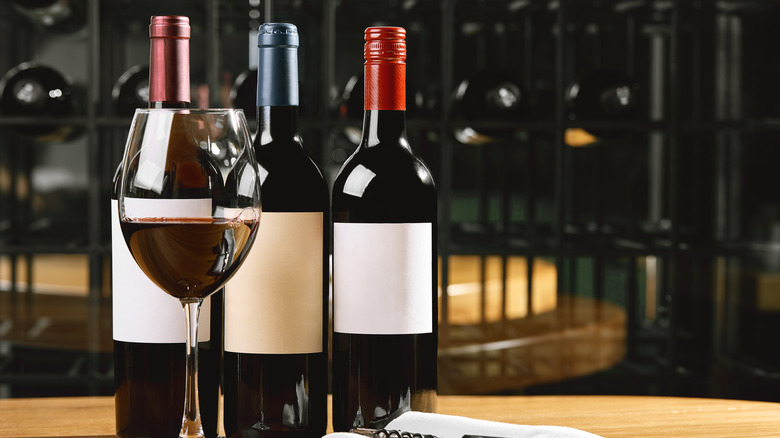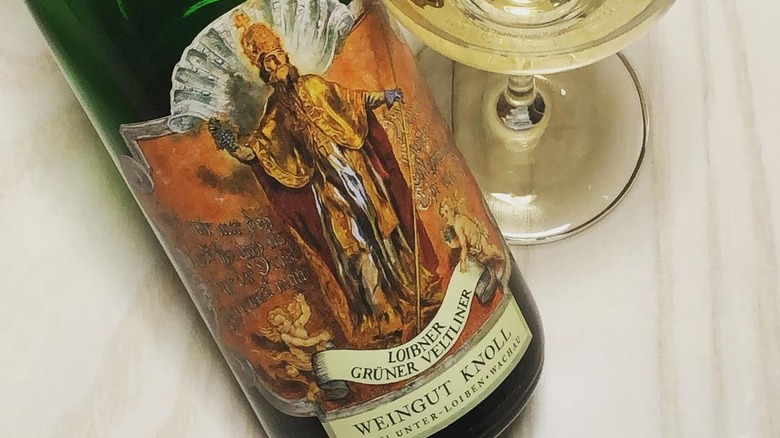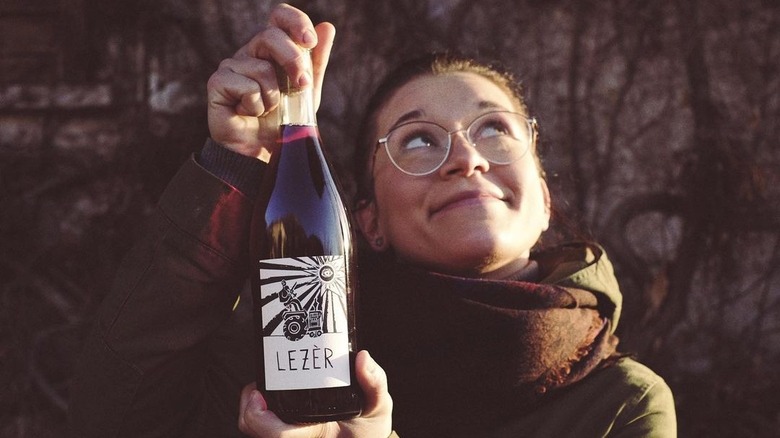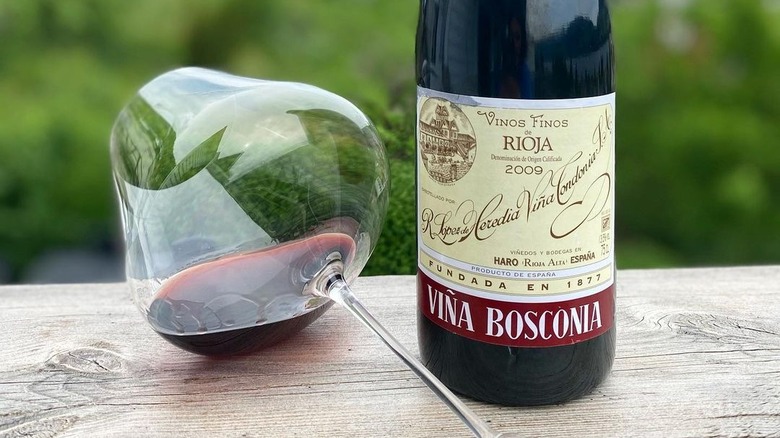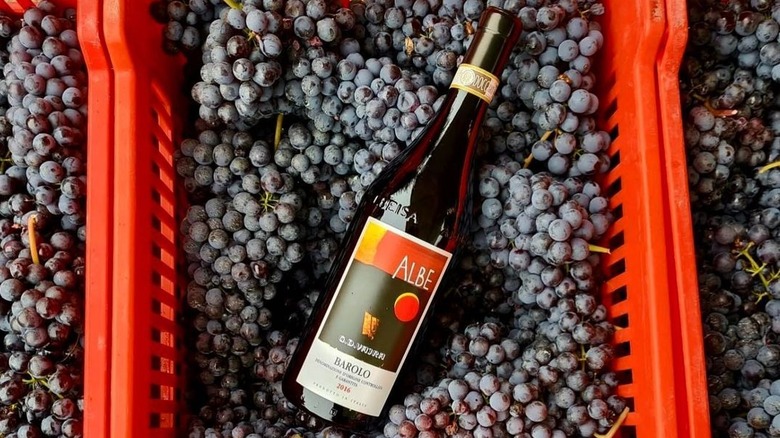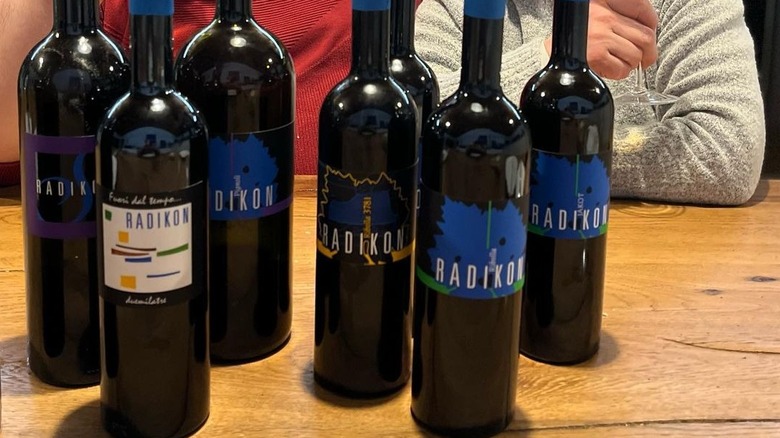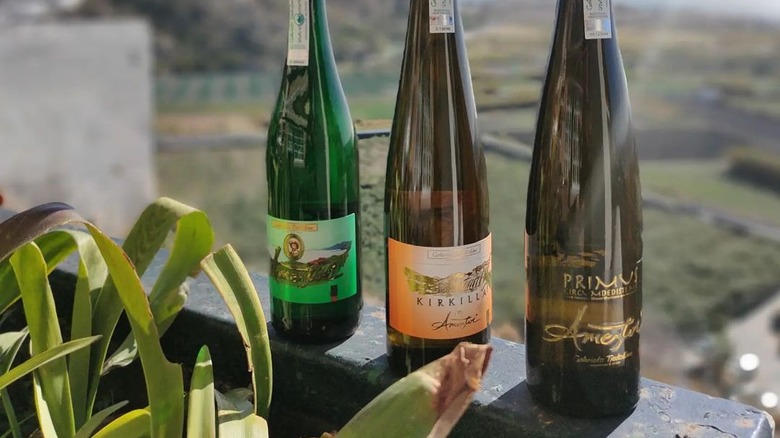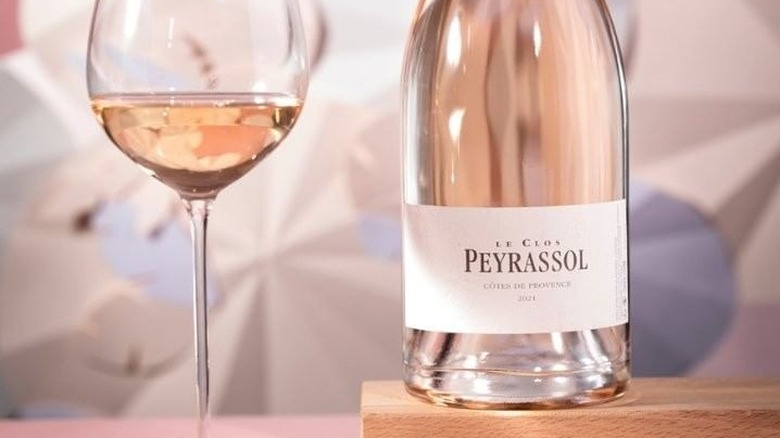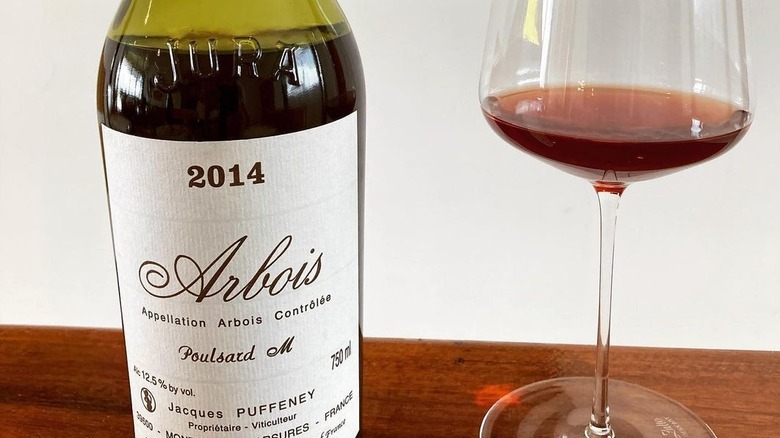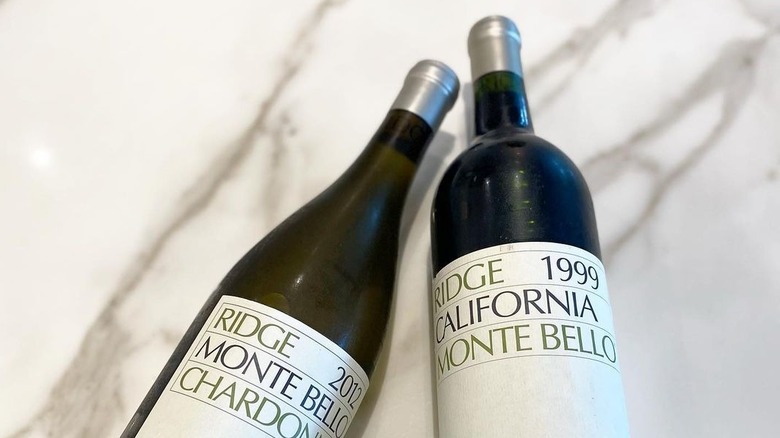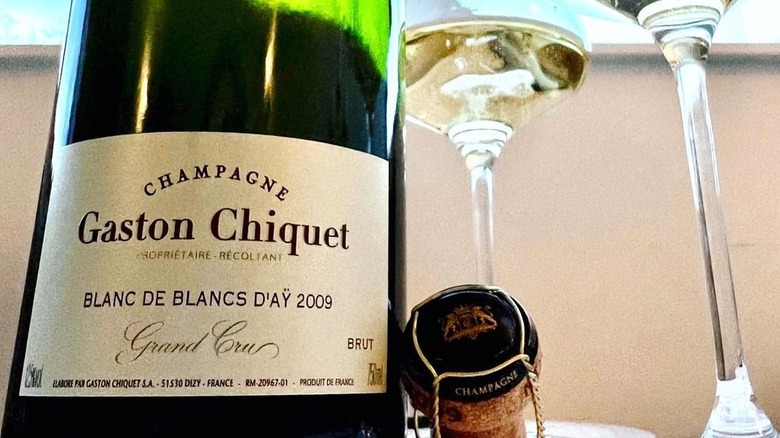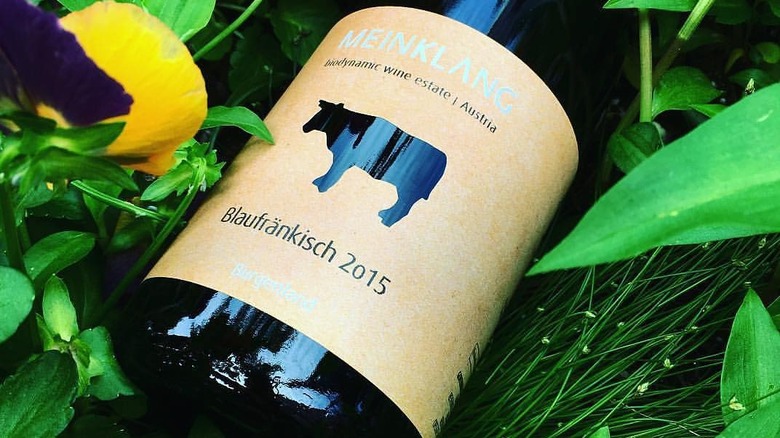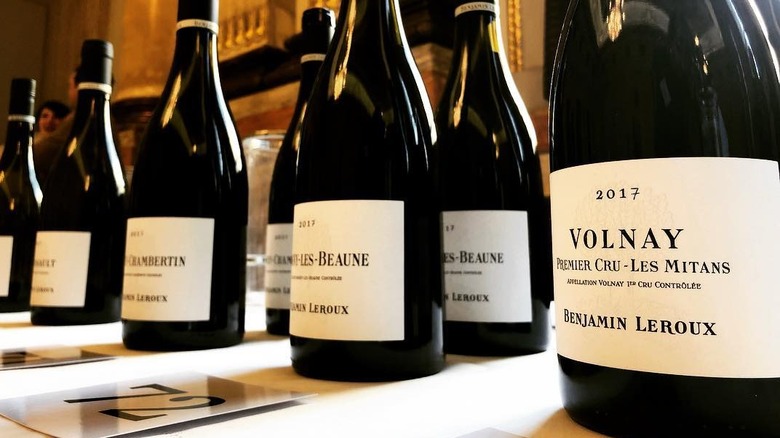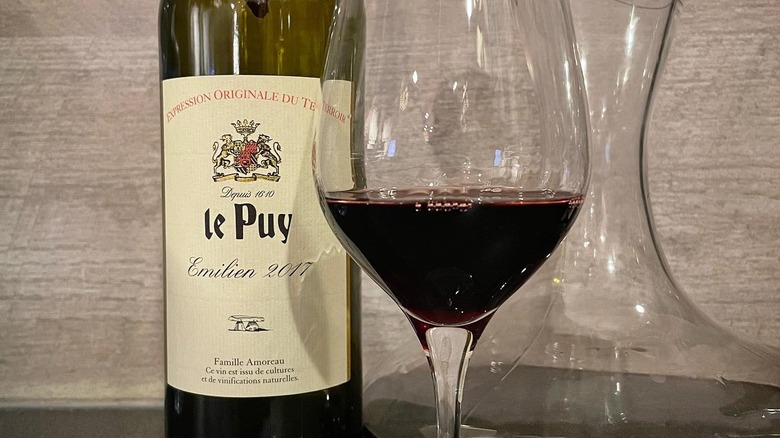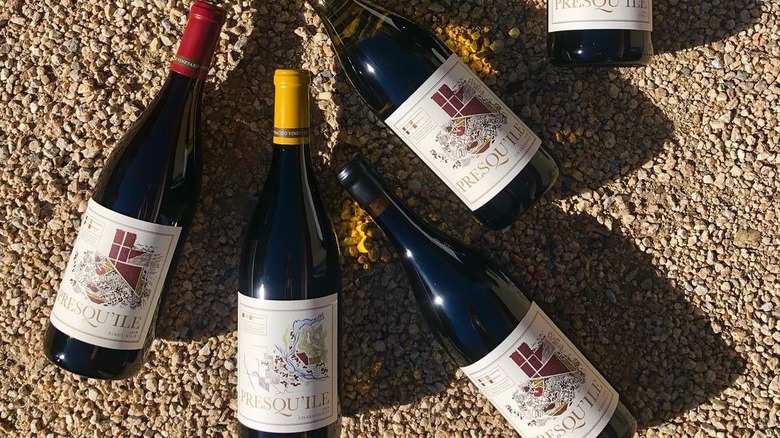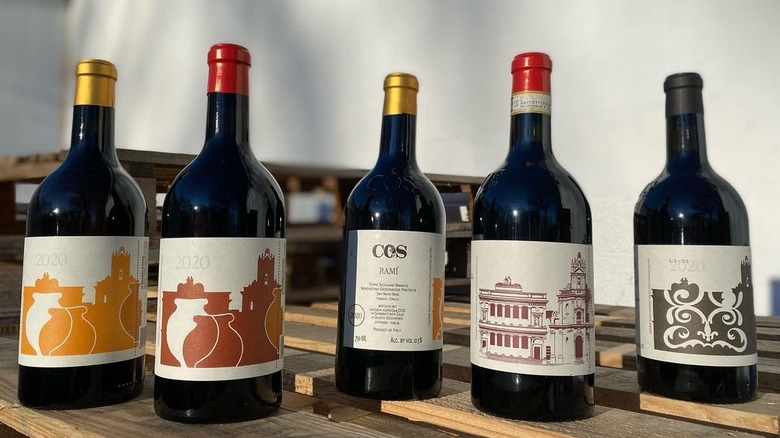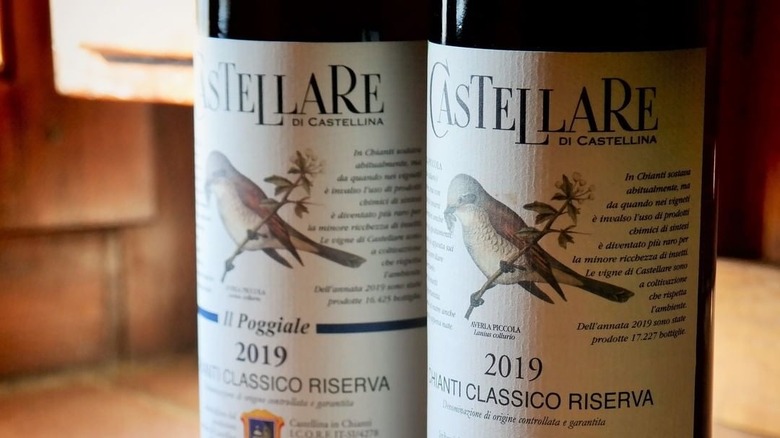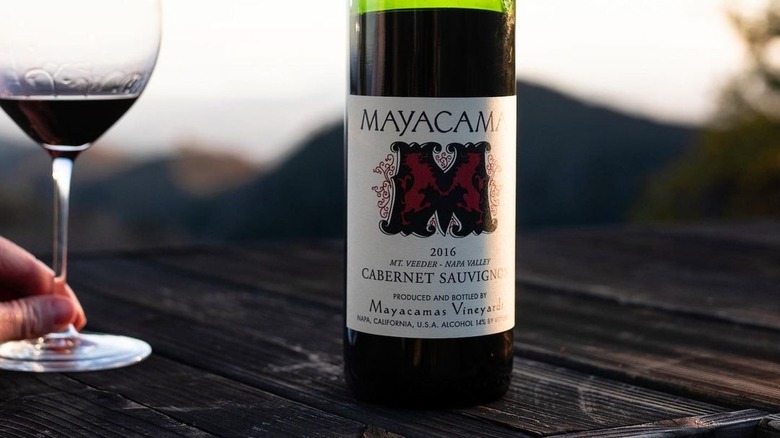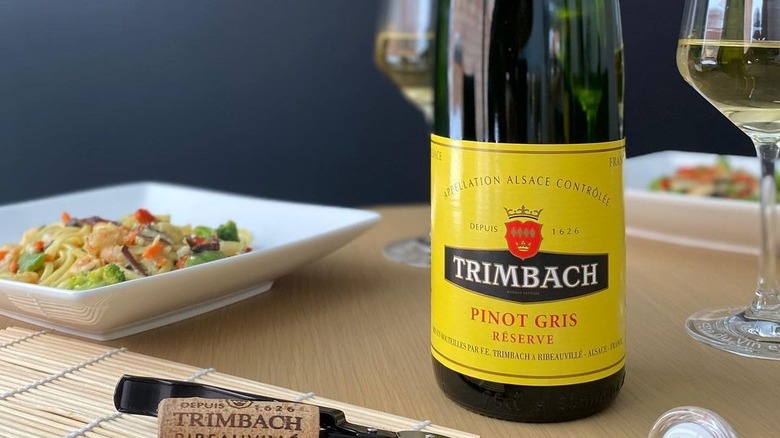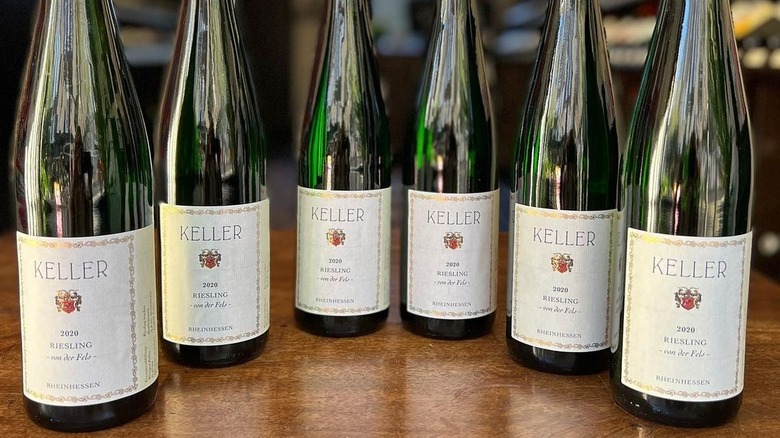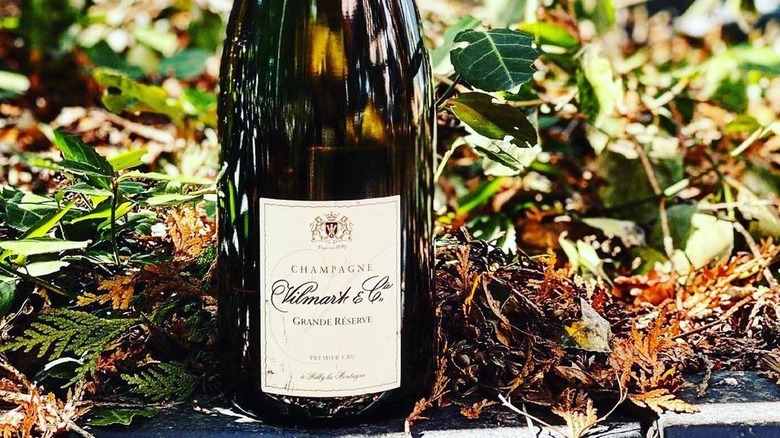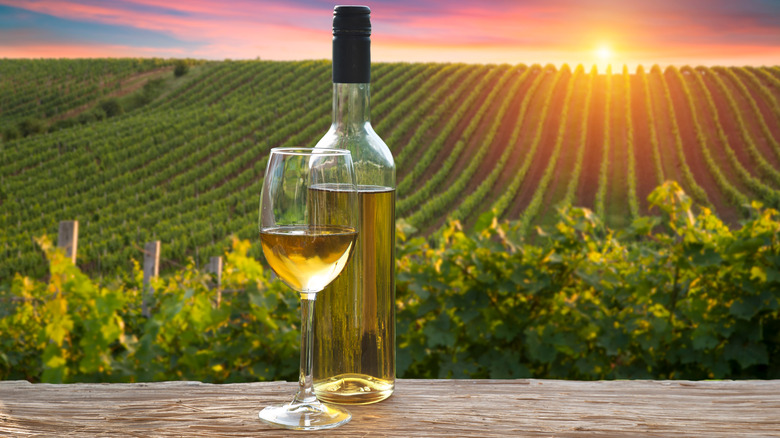20 Can't-Miss Wine Brands To Buy In 2024
Assembling a list of the so-called best wine brands is akin to doing so with novels. After all, plucking a handful of favorites from thousands of options seems almost criminally reductive (particularly since one novel might accomplish something another never even set out to try). So it is with wine, where styles as disparate as glou-glou and Champagne jockey for their place on the modern drinker's shelf.
Of course, wine is more than just a drink — it's a shared experience that brings people together. In that sense, if you're planning a wine tasting party, you likely want to ensure your guests will enjoy the variety of bottles you purchase from the store. But in order to do so, it helps to know a little something about the wine you're buying (and eventually drinking).
What follows is a list of can't-miss wine brands that are top-tier choices for anybody serious about what goes in their glass. We considered numerous aspects when crafting this collection of high-quality wine brands. This includes taste, where it's made, whether it's farmed sustainably and ethically, its history, and affordability (among other factors). While rare and expensive gems might stud a collector's cellar, those aren't entirely useful for the everyday wine enthusiast. If you're looking for a fantastic vino that can be found regularly, affordably, and fairly easily? Here's our list of can't-miss wine brands you should buy.
1. Weingut Knoll
Austria is often overlooked as an option for the grab-and-go wine shopper, but it shouldn't be. The country has a rich winemaking tradition that tends to eschew big-box corporate production. Instead, this region is home to several small to medium-sized family operations that put out consistently excellent wines — and Weingut Knoll is one of those outfits.
Knoll bottled its first vintage in the 1950s. Since then, it has become one of the Wachau region's greatest wine producers. Its distinctive labels are arguably the most famous in all of Austria, bearing the likeness of Saint Urban – the patron saint of vine-dressers and vinters who hid from religious persecution in a vineyard before he became canonized. The sustainably-farmed vineyard focuses on traditional Austrian grapes like grüner veltliner, riesling, gelber muskateller, and traminer. Weingut Knoll also grows some pinot noir (called blauburgunder in Austria) and chardonnay, though in smaller quantities than its other grapes.
The wines of Weingut Knoll range from ultra-crisp, dry whites, and rosés, to delectably sweet dessert wines. Particularly delightful are the winery's rieslings and grüner veltliners with the "smaragd" designation — or a Wachau-specific term that indicates a wine of the highest quality made from the ripest grapes. You can expect medium and full-bodied white wines with great aging potential from this brand.
2. Azienda Agricola Foradori
Azienda Agricola Foradori is a family-run, biodynamic winery in the Trentino region of Italy. The operation is helmed by third-generation winemaker Elisabetta Foradori and her three children, Emilio, Theo, and Myrtha. The Foradoris' commitment to low-intervention, sustainable winemaking (which means something different depending on who you ask) checks all the natural wine fan's boxes without sacrificing the precision and quality of more conventionally made wine.
Most of the family's holdings are planted to Teroldego, a Northern Italian grape that produces robust reds. But you'll also find Foradori whites made from manzoni bianco and pinot grigio, as well as a gorgeous skin-contact wine made from a thin-skinned white grape called nosiola. While some of Foradori's reds are indeed the medium to full-bodied baddies that the Teroldego grape name conjures, the winery also puts out Lezèr, a decidedly lighter-style Teroldego blend that's intended to be chilled and drunk during the summer.
Foradori is a wonderful combination of old and new. The current stewards honor their forebears by producing wines of great typicity while remaining open to modern innovation and evolution.
3. López de Heredia
The Rioja region of Spain is world-renowned for its production of full-bodied, earthy reds made from the tempranillo grape. Chief among the region's wineries is López de Heredia. This family brand is perhaps the finest Rioja producer around, known for its classically styled and age-worthy Tempranillos. The López de Heredia winery was founded in 1877, and today the family takes an if-it-ain't-broke approach to winemaking — forgoing modern winemaking trends and technology in favor of their time-tested methods.
López de Heredia's four most famous holdings are the Tondonia, Cubillo, Bosconia, and Zaconia vineyards, and you'll find the different bottlings labeled as such: Viña Tondonia, Viña Cubillo, and so on. Tondonia is the star player of the quartet and produces the brand's most famous wine. These Tempranillos are dusty, earthy, full-bodied reds good for a cool autumn evening or to pair with heartier fare like steak or stew. If you're looking for a delicious old-school red, López de Heredia is it.
4. G.D. Vajra
No wine list would be complete without a nod to Italy's Piedmont region, which produces some of the most sought-after wines in the world. It's difficult to pick a single brand from the many amazing Piedmontese producers, but G.D. Vajra is our choice for its variety of offerings, accessibility, and consistent quality.
G.D. Vajra's story started in the late 1960s, when Aldo Vajra was plucked out of student protests by his worried father and shipped off to his grandparents' farm in Piedmont to stay out of trouble. The summer spent there ignited a lifelong passion, and the Vajra family has grown its operation over the last five decades to be one of the best in the region. Siblings Giuseppe, Francesca, and Isidoro run the show in the 2020s, and continue the work that earned their father the moniker "the most traditional of the modernists and the most modern of the traditionalists."
The prestigious wines of Piedmont often come with hefty price tags, but Vajra's offerings start in the low $20 range and include everything from the region's famed nebbiolo grape to barbera, dolcetto, moscato, and riesling. Even the brand's nebbiolo from the famously pricy region of Barolo doesn't always break the bank, with some vintages clocking in around $45-50. Vajra produces consistently delicious stuff in an environmentally conscious way — what's not to love?
5. Radikon
The last decade has seen an explosion in the demand for and popularity of orange wine. Everybody and their mother is making the stuff now, but Radikon was one of the first producers — pioneering this style of wine before it was cool. The late Stanko Radikon's philosophy of organic production and steadfast commitment to championing skin-contact wines was lifted directly from his grandfather, who was making orange wine as early as the 1930s.
The Radikon winery is located in the Friuli region of Italy, but sits on the border of Slovenia. Consequently, it's associated more with the Slovenian style of orange winemaking than the traditional Friulian school of wine production. Stanko's family assumed control of the Radikon vineyards after his passing in 2016 and continue to release vintage after vintage of amazing oranges and reds.
Though most famous for its Tocai Friulano and Ribolla Gialla, though the vineyard also grows chardonnay, sauvignon, merlot, pinot grigio, and others. Don't be surprised if the bottles look a bit small, either. One of Stanko's quirky beliefs was that 750-milliliter bottle was too much to split comfortably between two people over a meal, so he chose to bottle much of his wine in half-liter sizes. Whether you're just getting into orange wine or you're already a fan, Radikon should be on your list.
6. Ameztoi
Ameztoi's Txakolina wine is one of those discovery bottles that never fails to delight. Hailing from the Basque region of Northeastern Spain, Txakolina is an ideal summertime drink given it's a low-alcohol, slightly effervescent style of wine. Though tradition dictates Txakolina be strictly white, Ameztoi has evolved with the times and makes both rosé and red variations.
For us, Ameztoi makes the list for its contribution to the rosé genre. Txakolina is a different beast than your classic Provencal style of rosé, but no less delicious. This is the stuff you want to drink on a patio or at the beach. It's bubbly, it goes down easy, and it's low-octane enough that you can have that extra glass without too much worrying. Ameztoi's whites and rosés are zippy and well-balanced, and the reds are energetic and light on their feet. Once you've graduated from Ameztoi's traditional Txakoli, try one of the brand's full-on sparkling wines or aguardiente liquors — they won't disappoint.
7. Commanderie de Peyrassol
It's hard to crown rosé royalty, given the many deserving contenders for the throne. But if we had to do it, Commanderie de Peyrassol gets coronated. Wine geeks around the world will bicker about their favorite style of the pink stuff, but it's tough to argue against France's Provence region when it comes to what you might call "classic" rosé: pale, crisp, dry, and drinkable.
Among the many Provencal producers, Commanderie de Peyrassol is a worthy contender for the crown. The Commanderie was founded by the Knight's Templar in 1256 and has been at work making wine for close to 800 years. Currently owned by the Austruy family, Peyrassol engages in organic winemaking practices and puts out beautiful wines each year. The winery's portfolio does include whites and reds, but among wine professionals, the name is synonymous with rosé. This is the brand to reach for when you want a sleek, clean, quaffable glass of rosé.
8. Jacques Puffeney
France's Jura region is a quiet treasure trove of wine. Though less famous than other regions of France to explore through wine – including its neighbor Burgundy — the region produces reds and whites that are quirky, intriguing sidesteps from Burgundian mainstays. Among the handful of heavy-hitting Jura brands, Jacques Puffeney reigns supreme. Or, at least, Jacques himself did reign supreme until he sold his estate to the d'Angerville family of Burgundy in 2014.
The d'Angervilles took control of the Puffeney brand when Jacques decided to retire. Under the d'Angervilles' stewardship, the brand continues to produce wine made from the region's traditional red grapes poulsard, trousseau, and pinot noir grapes as well as whites made from savagnin and chardonnay.
The Puffeney brand represents everything we love about the Jura. Its light, funky red reds offers a fun departure from the more mainstream pinot noirs of Burgundy, and its nutty, sometimes oxidative whites are full, round expressions of chardonnay and savagnin unlike any domestic white you've ever tried. If Jura has an ambassador to the world, Puffeney is it.
9. Ridge
Ridge is everything that a brand making traditionally-styled California wine should aspire to be. A wine that displays power with elegance, structure with finesse, and became certified organic in 2022. Plenty of California producers are skewing new school these days, producing fun and funky natural wines with cult followings and flashy branding. Ridge isn't that, and it doesn't try to be. It's a traditionalist outfit that embraces natural winemaking philosophy without sacrificing its old-school sensibilities.
Ridge's focus is on cabernet sauvignon, zinfandel, and chardonnay, with a healthy dose of Rhône varieties like viognier, grenache, and roussanne, rounding out its portfolio. But cabernet is what made it famous, and is what continues to set Ridge apart from the competition. You can throw a stone in Northern California and hit a winery producing over-extracted, in-your-face, unbalanced reds. But that winery won't be Ridge. Instead, expect gorgeous expressions of the grape that get your blood flowing without bowling you over. If Bordeaux asked a question, Ridge is California's answer.
10. Gaston Chiquet
Wine is often as much about storytelling as it is about what's in the glass. And while some of the venerable old houses of Champagne make amazing products, they've drifted towards the commercial and impersonal over time to become — as a wise fellow once said – more machine than man. Not so with Gaston Chiquet, a grower Champagne brand that grows and vinifies its own grapes as opposed to sourcing grapes from other growers (as is common practice among some of the larger houses).
Gaston Chiquet plants half of its vineyards to chardonnay, with the remaining 50% split 30/20 between the red grapes pinot meunier and pinot noir. Gaston Chiquet is one of the finest producers of blanc de blancs – literally "white from whites" — a style of Champagne that uses only chardonnay grapes and produces wines of elegance and finesse.
Gaston Chiquet earns its spot on this list as an emblem of everything that makes grower Champagnes great. A careful, hands-on approach in the cultivation of the land, vinification of the grapes, and distribution of the product. Plus, you can snag a bottle for around $50 — which, for Champagne, is an absolute steal.
11. Meinklang
If Weingut Knoll is the ambassador of traditional Austrian wine done right, Meinklang is the champion of new school practices and modern trends. It's hard to browse the shelves of any wine shop these days without bumping into the brand's trademark cow label — and for good reason. The Michlits family who owns and operates the Demeter-certified Meinklang brand in eastern Austria puts out hit after hit, offering virtually every type of natural wine under the sun including white, red, orange, rosé, and pét-nat. And they do so all while farming biodynamically, which is no easy feat.
Meinklang earns its spot on this list as an industry leader in the natural wine movement. It wasn't the first brand to farm biodynamically, but it's hard to think of one who's done more to popularize and normalize the idea of biodynamic farming as an important variable when weighing your next purchase. It's true that this list doesn't require a brand to be natural to earn a place, but it would be short-sighted not to factor in which way the wind is blowing in the wine industry when considering what brands to include.
Natural wine production is here to stay, and Meinklang is making some of the best stuff in its genre. Plus, it's widely available and very affordable, allowing budget-conscious drinkers an opportunity to try excellent natural wine without breaking the bank.
12. Domaine Benjamin Leroux
We would be remiss not to include a Burgundian producer on this list. But how to choose? When examining what is arguably the best wine region in the world — and certainly one that commands some of the highest prices — it's impossible to name a producer who is objectively better than the others. Solving that problem is Benjamin Leroux, an all-things-to-all-people producer in Burgundy who was given control of Domaine du Comte Armand when he was just 24 years old. The wunderkind stayed on as Comte Armand's winemaker for 15 vintages before starting his own domaine in 2007.
Leroux now has holdings all over, from the white-producing region of Chassagne-Montrachet to the famous pinot noir region of Gevrey-Chambertin. And, unlike some of its contemporaries, Domaine Benjamin Leroux has a ton of options under $100. If you want to explore a broad variety of what Burgundy has to offer, look no further than Benjamin Leroux.
13. Chateau le Puy
Choosing a Bordeaux brand to include on this list shouldn't be hard, mainly because Bordeaux already did the work for us back in 1855. The problem lies in both accessibility and quality: What is readily available and affordable, but still consistently delicious? Chateau Margaux, for instance, makes amazing stuff — but it'll often set you back a few hundred bucks for a bottle. Enter Chateau le Puy, a house run by the Amoreau family, who have been producing wine since 1610.
Fifteen generations of practice have perfected Chateau le Puy's product. Their reds are stunning examples of right-bank Bordeaux, emphasizing the merlot grape with backup singers cabernet sauvignon and cabernet franc fleshing out the wines for structured, fruit-driven, but ultimately well-balanced reds. The chateau also plants some of its parcels to sémillon, one of the two major white grapes permitted in the Bordeaux region. And they even make a lovely rosé, which is not common among major Bordeaux producers but is a welcome addition to le Puy's arsenal. This rosé is a far cry from the Provencal style, instead offering a dark pink hue and a rich, concentrated burst of fruit on the palate.
Chateau le Puy, like nearly any other Bordeaux producer, has bottles that cost a pretty penny. But they've also got options starting in the $20 range, which makes them a no-brainer if you're looking to dive into Bordeaux on a budget.
14. Presqu'ile Wines
For four generations, the Murphy family farmed land in Arkansas and Louisiana. Then, in 2007, they founded Presqu'ile Wines and undertook the mission of locating land especially suited to grow cool-climate pinot noir and chardonnay. According to its website, Presqu'ile ultimately found a home in the Santa Maria Valley, and for 15 years has been doing California proud with its domestic take on the classic red and white wines of Burgundy.
Though its focus is mainly on pinot and chardonnay, Presqu'ile also grows a lesser amount of syrah, nebbiolo, and gamay. The winery's New World take on those Old World classics is a welcome addition to California's wine scene. While Presqu'ile does adhere to the same sustainable farming tenets that many of its peers espouse, the brand skips the culty, who-can-be-the-weirdest winemaking trend that produces funky bottles whose labels are often more enjoyable than their contents. Instead, Presqu'ile is releasing precise, quality wines that hold their own against any of the more famous — and pricier — pinot/chardonnay producers in the U.S.
If you ever find yourself in the area and are tempted to visit, do it! Presqu'ile leases some of their lands to Amplify Wines, a husband/wife team who makes amazing stuff, so the stop is a two-for-one win.
15. COS
Azienda Agricola COS — stylized often as just COS, and pronounced to rhyme with "dose" — was founded in Sicily in 1980 by three friends, Giambattista Cilia, Giusto Occhipinti, and Cirino Strano (the first letter of each last name forms the winery's name). For more than 40 years, COS has set the standard for Sicilian wine, popularizing the Nero D'Avola and Frappato blend known on the island as Cerasuolo di Vittoria and releasing other single-varietal reds and whites that are as delicious as they are approachable.
COS earns its spot on this list for putting Sicily on the global map. With its recognizable short, squat bottles, COS has made its way onto wine lists and into wine shops across the world with its beautiful expressions of native Sicilian grapes that might otherwise languish unsung. And, too, the brand has an ongoing familial legacy: Giusto Occhipinti's niece Arianna is a talented winemaker in her own right, helming Agricola Occhipinti, whose wines are just as delicious as COS's.
If you're a fan of Beaujolais or Burgundy reds, take a step outside your comfort zone and try COS. You won't regret it.
16. Castellare di Castellina
You might know chianti best as the thing that Hannibal Lecter likes to drink with his fava beans. But Castellare di Castellina is a brand producing so much more than meme-worthy wine. The winery, which is located in the Tuscan subregion of chianti classico, plants only native Tuscan grapes and produces some of the best sangiovese in the world. Though many Tuscan winemakers are entrenched in traditionalist winemaking and tend to pooh-pooh modern trends, Castellare di Castellina is fully on board with the natural wine movement, and forbids the use of any chemical products on their land.
The brand isn't shy about its commitment to environmentalism, either. Each vintage sports a different bird on the label, many of which are endangered by pollution and hunting. Plus, the wine is just bonkers good. If you're looking for an affordable medium- to full-bodied sangiovese, look no further than Castellare di Castellina.
17. Mayacamas Vineyards
Talk to anybody with a fondness for California cabernet sauvignon, and Mayacamas Vineyards will likely turn up near the top of their list. Though it has changed hands a few times over its 125-year history, the brand has been a consistent powerhouse of California wine since its inception in 1889. Consistently reputed to be one of the state's finest producers of cabernet and chardonnay, Mayacamas makes wine that is classic Napa cab in every sense: big and bold, with robust tannins and impressive age-worthiness. Its whites are no joke, either: The chardonnays are aged in oak and present as full, round, powerful wines that can stand up to any dish you throw at them.
The Schottenstein family took over Mayacamas in 2013 and has recently made hires to introduce organic viticulture to the winery, according to the Mayacamas website. Though the stuff doesn't come cheap — the least expensive bottles start around $60 in most places — it's well worth it if you want to experience a truly traditional expression of California cab or chardonnay.
18. Maison Trimbach
Skirting France's German border is the culturally ambiguous wine region of Alsace. Though legally part of France, Alsace is often considered more culturally German and is thus hard to categorize and classify when talking about its wine. But no matter what side of the French/German argument you fall on, it's easy to agree that Maison Trimbach is one of the region's finest producers. The winery has been operating since 1626, and its current offerings showcase classic Alsatian varietals like riesling, pinot blanc, pinot gris, sylvaner, and gewürztraminer.
The family operation is still run by 12th-generation winemaker Pierre Trimbach and his brother Jean, who carry on the winery's tradition of producing Alsatian wines that are true to the region's style and showcase its terroir. Trimbach is especially known for its dry rieslings. If you're scared of that grape, this is the producer who might turn you around. These supple, bone-dry rieslings are amazing discovery wines that'll have you asking for Alsace again and again.
19. Keller
If you dipped your toe in the water with an Alsatian wine and liked what you found, Keller is a natural progression to a true German riesling. Celebrated wine professional Jancis Robinson once famously said, according to Vom Boden, "if I had to choose one wine to show how great dry German riesling can be, I would choose a Keller riesling. Those wines are the German Montrachets." If that doesn't mean anything to you, it's wine geek shorthand for: These wines are really, really incredible.
What makes Keller's success as a brand more impressive is that they're located in a so-so part of the Rheinhessen, a region that itself lacks a great winemaking reputation. And yet husband and wife team Klaus-Peter and Julia Keller continue to release winners each year, delighting riesling enthusiasts around the world. Though not the easiest wines to find, due to limited supply and heavy demand, Keller is still accessible for a sharp-eyed shopper. The secret delights of German riesling haven't been fully outed in the everyday drinking community, and now is the time to take advantage of that lapse in judgment.
20. Vilmart & Cie.
Pop the cork! Vilmart & Cie is a Champagne house established in 1890 that's currently under control of a fifth-generation winemaker. The Vilmart brand is the best of Champagne's two worlds: a relatively small grower-estate whose wine is a match in quality for any of the largest names in the region. The brand's winemaker oversees the hand-harvesting and selection of its vineyards finest grapes, and then vinifies in wood, which is said to lend body, fruit, and roundness to the wines which stainless steel just can't match.
Interesting, too, is Vilmart's decision to deliberately forego malolactic fermentation, thereby guaranteeing a brighter, more linear style of Champagne. This is lean, clean bubbly for every occasion. And Vilmart's entry-level bottles start around the $70 range, which means you can have top-tier Champagne for a relatively affordable price.
Now, there may be no "best" wine in the world. But there are certainly "desert island wines" you'd pick from among all the other options — and this just might be ours.
Methodology
There are literally countless potential aspects to consider when it comes to can't-miss wine brands — many of which we considered when crafting this list. This includes the people producing the wine and their location when doing so, a brand's history, and its farming methods, as well as a brand's accessibility, affordability, and taste (of course).
The recommendations made in this article are based on the writer's personal expertise and firsthand experience tasting most (if not all) of the included wine brands. Additionally, the selections and opinions expressed in this article were informed by the writer's professional experience working at wine bars.
